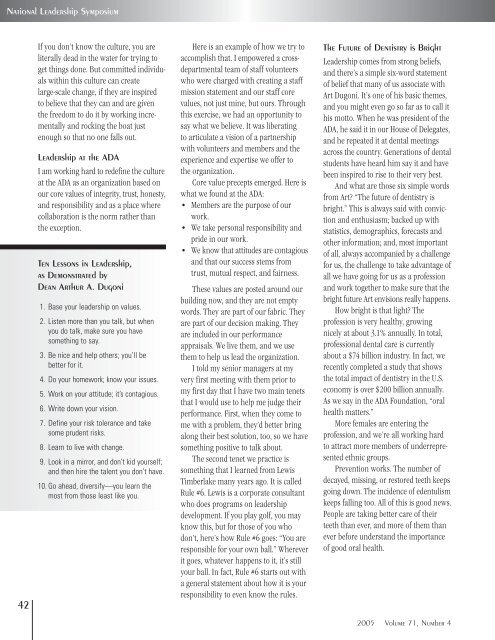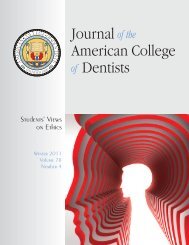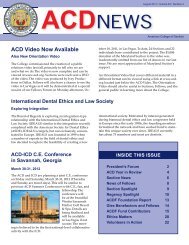JACD 71-4 - American College of Dentists
JACD 71-4 - American College of Dentists
JACD 71-4 - American College of Dentists
- No tags were found...
Create successful ePaper yourself
Turn your PDF publications into a flip-book with our unique Google optimized e-Paper software.
National Leadership Symposium<br />
42<br />
If you don’t know the culture, you are<br />
literally dead in the water for trying to<br />
get things done. But committed individuals<br />
within this culture can create<br />
large-scale change, if they are inspired<br />
to believe that they can and are given<br />
the freedom to do it by working incrementally<br />
and rocking the boat just<br />
enough so that no one falls out.<br />
Leadership at the ADA<br />
I am working hard to redefine the culture<br />
at the ADA as an organization based on<br />
our core values <strong>of</strong> integrity, trust, honesty,<br />
and responsibility and as a place where<br />
collaboration is the norm rather than<br />
the exception.<br />
Ten Lessons in Leadership,<br />
as Demonstrated by<br />
Dean Arthur A. Dugoni<br />
1. Base your leadership on values.<br />
2. Listen more than you talk, but when<br />
you do talk, make sure you have<br />
something to say.<br />
3. Be nice and help others; you’ll be<br />
better for it.<br />
4. Do your homework; know your issues.<br />
5. Work on your attitude; it’s contagious.<br />
6. Write down your vision.<br />
7. Define your risk tolerance and take<br />
some prudent risks.<br />
8. Learn to live with change.<br />
9. Look in a mirror, and don’t kid yourself;<br />
and then hire the talent you don’t have.<br />
10. Go ahead, diversify—you learn the<br />
most from those least like you.<br />
Here is an example <strong>of</strong> how we try to<br />
accomplish that. I empowered a crossdepartmental<br />
team <strong>of</strong> staff volunteers<br />
who were charged with creating a staff<br />
mission statement and our staff core<br />
values, not just mine, but ours. Through<br />
this exercise, we had an opportunity to<br />
say what we believe. It was liberating<br />
to articulate a vision <strong>of</strong> a partnership<br />
with volunteers and members and the<br />
experience and expertise we <strong>of</strong>fer to<br />
the organization.<br />
Core value precepts emerged. Here is<br />
what we found at the ADA:<br />
• Members are the purpose <strong>of</strong> our<br />
work.<br />
• We take personal responsibility and<br />
pride in our work.<br />
• We know that attitudes are contagious<br />
and that our success stems from<br />
trust, mutual respect, and fairness.<br />
These values are posted around our<br />
building now, and they are not empty<br />
words. They are part <strong>of</strong> our fabric. They<br />
are part <strong>of</strong> our decision making. They<br />
are included in our performance<br />
appraisals. We live them, and we use<br />
them to help us lead the organization.<br />
I told my senior managers at my<br />
very first meeting with them prior to<br />
my first day that I have two main tenets<br />
that I would use to help me judge their<br />
performance. First, when they come to<br />
me with a problem, they’d better bring<br />
along their best solution, too, so we have<br />
something positive to talk about.<br />
The second tenet we practice is<br />
something that I learned from Lewis<br />
Timberlake many years ago. It is called<br />
Rule #6. Lewis is a corporate consultant<br />
who does programs on leadership<br />
development. If you play golf, you may<br />
know this, but for those <strong>of</strong> you who<br />
don’t, here’s how Rule #6 goes: “You are<br />
responsible for your own ball.” Wherever<br />
it goes, whatever happens to it, it’s still<br />
your ball. In fact, Rule #6 starts out with<br />
a general statement about how it is your<br />
responsibility to even know the rules.<br />
The Future <strong>of</strong> Dentistry is Bright<br />
Leadership comes from strong beliefs,<br />
and there’s a simple six-word statement<br />
<strong>of</strong> belief that many <strong>of</strong> us associate with<br />
Art Dugoni. It’s one <strong>of</strong> his basic themes,<br />
and you might even go so far as to call it<br />
his motto. When he was president <strong>of</strong> the<br />
ADA, he said it in our House <strong>of</strong> Delegates,<br />
and he repeated it at dental meetings<br />
across the country. Generations <strong>of</strong> dental<br />
students have heard him say it and have<br />
been inspired to rise to their very best.<br />
And what are those six simple words<br />
from Art? “The future <strong>of</strong> dentistry is<br />
bright.” This is always said with conviction<br />
and enthusiasm; backed up with<br />
statistics, demographics, forecasts and<br />
other information; and, most important<br />
<strong>of</strong> all, always accompanied by a challenge<br />
for us, the challenge to take advantage <strong>of</strong><br />
all we have going for us as a pr<strong>of</strong>ession<br />
and work together to make sure that the<br />
bright future Art envisions really happens.<br />
How bright is that light? The<br />
pr<strong>of</strong>ession is very healthy, growing<br />
nicely at about 3.1% annually. In total,<br />
pr<strong>of</strong>essional dental care is currently<br />
about a $74 billion industry. In fact, we<br />
recently completed a study that shows<br />
the total impact <strong>of</strong> dentistry in the U.S.<br />
economy is over $200 billion annually.<br />
As we say in the ADA Foundation, “oral<br />
health matters.”<br />
More females are entering the<br />
pr<strong>of</strong>ession, and we’re all working hard<br />
to attract more members <strong>of</strong> underrepresented<br />
ethnic groups.<br />
Prevention works. The number <strong>of</strong><br />
decayed, missing, or restored teeth keeps<br />
going down. The incidence <strong>of</strong> edentulism<br />
keeps falling too. All <strong>of</strong> this is good news.<br />
People are taking better care <strong>of</strong> their<br />
teeth than ever, and more <strong>of</strong> them than<br />
ever before understand the importance<br />
<strong>of</strong> good oral health.<br />
2005 Volume <strong>71</strong>, Number 4





